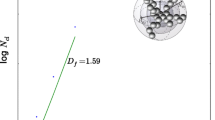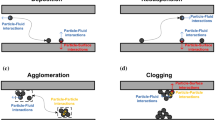Abstract
A computational study is reported on the growth of aggregates in flow of a particulate suspension through a micro-nozzle. The study employs a soft-sphere discrete element method (DEM) with van der Waals adhesion force between the particles in two-dimensional, incompressible channel flow. A new computational approach for particle transport in complex domains is developed which uses a background Cartesian grid for efficient flow field interpolation at the particle locations, together with a level-set method to represent the nozzle boundaries in the particle computation. Three mechanisms for the growth or breakup of particulate aggregates in the micro-nozzle are examined: (1) enhanced particle collision due to lateral compression as fluid elements pass through the nozzle, (2) stretching of aggregates due to axial stretching of fluid elements, and (3) collision and intermittent adhesion of particles to the nozzle wall. The first of these mechanisms leads to aggregate growth, and the second to aggregate breakup. The wall collision and adhesion mechanism can enhance either aggregate growth or breakup, but it is found in most cases to be a primary agent in the breakup of incident aggregates as part of the aggregate attaches to the nozzle wall and is torn from the remainder of the aggregate due to the high shear near the walls. Simplified models for these processes are developed and used to interpret the trends observed in the DEM simulations. The effects of particle adhesion parameter, particle size and density, particle concentration, and nozzle geometry are examined. It is found that passage of a particulate suspension through a nozzle can lead to either a substantial decrease in aggregate size or a modest increase under different conditions, depending in part on the size of the incident aggregates.
















Similar content being viewed by others
References
Alexeenko AA, Levin DA, Fedosov DA, Gimelshein SF (2003) Coupled thermal-fluid modeling of micro-nozzles for performance analysis. In: 39th AIAA/ASME/ASEE Joint Propulsion Conference, AIAA paper 2003-4717, July 20–23
Allievi A, Bermejo R (1997) A generalized particle search-locate algorithm for arbitrary grids. J Comput Phys 132:157–166
Bagi K, Kuhn MR (2004) A definition of particle rolling in a granular assembly in terms of particle translations and rotations. J Appl Mech 71:493–501
Bergendahl J, Grasso D (2000) Prediction of colloid detachment in a model porous media: hydrodynamics. Chem Eng Sci 55:1523–1532
Burd AB, Jackson GA (2002) Modeling steady-state particle size spectra. Environ Sci Technol 36:323–327
Chen YF, Yang JM, Gau JJ, Ho CM, Tai YC (2000) Microfluidic system for biological agent detection. In: 3rd international conference on the interaction of art and fluid mechanics, Zurich, Switzerland
Chokshi A, Tielens AGGM, Hollenbach D (1993) Dust coagulation. Astrophys J 407:806–819
Di Felice R (1994) The voidage function for fluid-particle interaction systems. Int J Multiph Flow 20:153–159
Dominik C, Tielens AGGM (1995) Resistance to rolling in the adhesive contact of two elastic spheres. Philos Mag A 92(3):783–803
Ferry J, Balachandar S (2001) A fast Eulerian method for disperse two-phase flow. Int J Multiph Flow 27:1199–1226
Fletcher DA, Palanker DV, Huie P, Miller J, Marmor MF, Blumenkranz MS (2002) Intravascular drug delivery with a pulsed liquid microjet. Arch Ophthalmol 120:1206–1208
Fuller SB, Wilhelm EJ, Jacobson JM (2002) Ink-jet printed nanoparticle microelectromechanical systems. J Microelectromech Syst 11(1):1057–1060
Hu KC, Mei R (1998) Particle collision rate in fluid flows. Phys Fluids 10(4):1028–1030
Issa R (1985) Solution of the implicit discretized fluid flow equations by operator splitting. J Comput Phys 62:40–65
Jeyaprakash JD, Samuel S, Steger R, Birkle G, Zengerle R, Koltay P, Ruhe J (2005) Modification of micronozzle surfaces using fluorinated polymeric nanofilms for enhanced dispensing of polar and nonpolar fluids. Anal Chem 77:6469–6474
Jiang XN, Zhou ZY, Li Y, Yang Y, Huang XY, Lin CY (1998) Micro-nozzle/diffuser flow and its application in micro valveless pumps. Sens Actuators A 70:81–87
Johnson KL, Kendall K, Roberts AD (1971) Surface energy and the contact of elastic solids. Proc R Soc Lond A 324:301–313
Joseph GG, Zenit R, Hunt ML, Rosenwinkel AM (2001) Particle–wall collisions in a viscous fluid. J Fluid Mech 433:329–346
Kim H, Arastoopour H (2002) Extension of kinetic theory to cohesive particle flow. Powder Technol 122:83–94
Konstandopoulos A (2000) Deposit growth dynamics: particle sticking and scattering phenomena. Powder Technol 109:262–277
Lai YG (2000) Unstructured grid arbitrarily shaped element method for fluid flow simulation. AIAA J 38(12):2246–2252
Lebbou K, Perrodin D, Chani VI, Brenier A, Tillement O (2006) Fiber single-crystal growth from the melt for optical applications. J Am Ceram Soc 89(1):75–80
Lee H, Chou K, Huang K (2005) Inkjet printing of nanosized silver colloids. Nanotechnology 16:2436–2441
Li SQ, Marshall JS (2007) Discrete-element simulation of micro-particle deposition on a cylindrical fiber in an array. J Aerosol Sci 38:1031–1046
Mädler L (2004) Liquid-feed aerosol reactors for one-step synthesis of nano-structured particles. KONA 22:107–120
Markelov GN, Ivanov MS (2001) A comparative analysis of 2D/3D micronozzle flows by the DSMC method. AIAA paper 2001-1008, January 8–11
Marshall JS (2007) Particle aggregation and capture by walls in a particulate aerosol channel flow. J Aerosol Sci 38:333–351
Maxey MR, Riley JJ (1983) Equation of motion for a small rigid sphere in a non-uniform flow. Phys Fluids 24:883–889
Park J, Chung S, Yun H, Cho K, Chung C, Han DC, Chang JK (2006) Asymmetric nozzle structure for particles converging into a highly confined region. Curr Appl Phys 6:992–995
Perry JL, Kandlikar SG (2008) Fouling and its mitigation in silicon microchannels used for IC chip cooling. Microfluid Nanofluid 5:357–371
Reyes DR, Iossifidis D, Auroux PA, Manz A (2002) Micro total analysis systems. 1. Introduction, theory, and technology. Anal Chem 74:2623–2636
Saffman PG, Turner JS (1956) On the collision of drops in turbulent clouds. J Fluid Mech 1:16–30
Serayssol JM, Davis RH (1986) The influence of surface interactions on the elastohydrodynamic collision of two spheres. J Colloid Interf Sci 114(1):54–66
Sethian JA (1996) A fast marching level set method for monotonically advancing fronts. Proc Natl Acad Sci USA 93:1591–1595
Smoluchowski M (1917) Versuch einer mathematischen Theorie der Koagulationskinetik kolloidaler Lösungen. Z Phys Chem 92:129–168
Stemme E, Stemme G (1993) A valveless diffuser/nozzle-based fluid pump. Sens Actuators A 39:159–167
Tsuji Y, Tanaka T, Ishida T (1992) Lagrangian numerical simulation of plug flow of cohesionless particles in a horizontal pipe. Powder Technol 71:239–250
van de Pol FCM (1989) A pump based on micro-engineering techniques. Ph.D. Thesis, University of Twente, The Netherlands
Yang KS, Chen IY, Shew BY, Wang CC (2004) Investigation of the flow characteristics within a micro-nozzle/diffuser. J Micromanuf Microeng 14:26–31
Zhang JJ, Li XY (2003) Modeling particle-size distribution dynamics in a flocculation system. AIChE J 49(7):1870–1882
Zhao Y, Marshall JS (2008) Spin coating of a colloidal suspension. Phys Fluids 20(4):043302-1–043302-15
Acknowledgments
The authors thank Greg Hewitt for providing the fluid flow computations for the paper. Funding was provided by the Caterpillar Technical Center, the U.S. Department of Transportation (grant number DTOS59-06-G-00048), and the Vermont EPSCoR Program (grant number EPS-0701410).
Author information
Authors and Affiliations
Corresponding author
Rights and permissions
About this article
Cite this article
Mousel, J.A., Marshall, J.S. Aggregate growth and breakup in particulate suspension flow through a micro-nozzle. Microfluid Nanofluid 8, 171–186 (2010). https://doi.org/10.1007/s10404-009-0451-4
Received:
Accepted:
Published:
Issue Date:
DOI: https://doi.org/10.1007/s10404-009-0451-4




